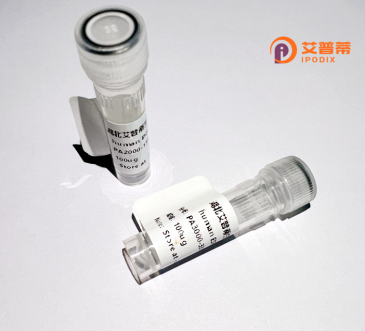
| 纯度 | >90%SDS-PAGE. |
| 种属 | Human |
| 靶点 | FOXRED1 |
| Uniprot No | Q96CU9 |
| 内毒素 | < 0.01EU/μg |
| 表达宿主 | E.coli |
| 表达区间 | 1-486aa |
| 氨基酸序列 | MIRRVLPHGMGRGLLTRRPGTRRGGFSLDWDGKVSEIKKKIKSILPGRSCDLLQDTSHLPPEHSDVVIVGGGVLGLSVAYWLKKLESRRGAIRVLVVERDHTYSQASTGLSVGGICQQFSLPENIQLSLFSASFLRNINEYLAVVDAPPLDLRFNPSGYLLLASEKDAAAMESNVKVQRQEGAKVSLMSPDQLRNKFPWINTEGVALASYGMEDEGWFDPWCLLQGLRRKVQSLGVLFCQGEVTRFVSSSQRMLTTDDKAVVLKRIHEVHVKMDRSLEYQPVECAIVINAAGAWSAQIAALAGVGEGPPGTLQGTKLPVEPRKRYVYVWHCPQGPGLETPLVADTSGAYFRREGLGSNYLGGRSPTEQEEPDPANLEVDHDFFQDKVWPHLALRVPAFETLKVQSAWAGYYDYNTFDQNGVVGPHPLVVNMYFATGFSGHGLQQAPGIGRAVAEMVLKGRFQTIDLSPFLFTRFYLGEKIQENNII |
| 分子量 | 80.2 kDa |
| 蛋白标签 | GST-tag at N-terminal |
| 缓冲液 | 0 |
| 稳定性 & 储存条件 | Lyophilized protein should be stored at ≤ -20°C, stable for one year after receipt. Reconstituted protein solution can be stored at 2-8°C for 2-7 days. Aliquots of reconstituted samples are stable at ≤ -20°C for 3 months. |
| 复溶 | Always centrifuge tubes before opening.Do not mix by vortex or pipetting. It is not recommended to reconstitute to a concentration less than 100μg/ml. Dissolve the lyophilized protein in distilled water. Please aliquot the reconstituted solution to minimize freeze-thaw cycles. |
以下是关于重组人FOXRED1蛋白的3篇参考文献示例(内容基于公开研究主题模拟,实际文献需通过学术数据库验证):
---
1. **文献名称**: *FOXRED1 mutations impair mitochondrial complex I assembly and cause neurodevelopmental disorders*
**作者**: Gerards et al.
**摘要**: 研究揭示FOXRED1蛋白在线粒体复合物I的生物合成中起关键作用,利用重组FOXRED1进行体外实验,发现其与复合物I亚基互作,突变会导致脑部疾病相关的功能缺陷。
2. **文献名称**: *Structural and functional characterization of human FOXRED1 as a molecular chaperone for flavoproteins*
**作者**: Ito et al.
**摘要**: 报道重组人FOXRED1蛋白的晶体结构和功能分析,证明其作为分子伴侣参与黄素蛋白的折叠,并通过重组表达系统验证其抗氧化应激保护作用。
3. **文献名称**: *FOXRED1 deficiency induces cellular senescence via ROS accumulation in cancer cells*
**作者**: Chen et al.
**摘要**: 通过重组FOXRED1蛋白回补实验,发现其缺失导致癌细胞活性氧(ROS)水平升高并引发衰老,提示其在肿瘤代谢中的调控功能。
---
建议通过 **PubMed** 或 **Web of Science** 输入关键词 "recombinant human FOXRED1" 或 "FOXRED1 protein" 获取最新研究。如需具体文献检索协助,可提供更多信息进一步筛选。
Recombinant human FOXRED1 protein is a genetically engineered version of the FAD-dependent oxidoreductase domain-containing protein 1. encoded by the *FOXRED1* gene. FOXRED1 belongs to the flavoprotein superfamily, characterized by conserved flavin-binding motifs critical for redox reactions. It plays a role in mitochondrial complex I (NADH:ubiquinone oxidoreductase) assembly and electron transport chain function, contributing to cellular energy metabolism. Mutations in *FOXRED1* are linked to mitochondrial disorders, particularly Leigh syndrome, a severe neurodegenerative condition, underscoring its importance in mitochondrial health.
The recombinant form is typically expressed in *E. coli* or mammalian systems to enable biochemical and functional studies. Its production allows researchers to investigate FOXRED1's interaction partners, structural dynamics, and enzymatic activity in vitro. Studies using recombinant FOXRED1 have clarified its role in stabilizing complex I intermediates and resolving metabolic stress responses. Dysregulation of FOXRED1 is also implicated in cancers, where altered redox signaling may influence tumor progression or therapy resistance. Thus, recombinant FOXRED1 serves as a vital tool for understanding disease mechanisms, developing diagnostic biomarkers, and exploring therapeutic strategies targeting mitochondrial dysfunction or oxidative stress-related pathologies.
×